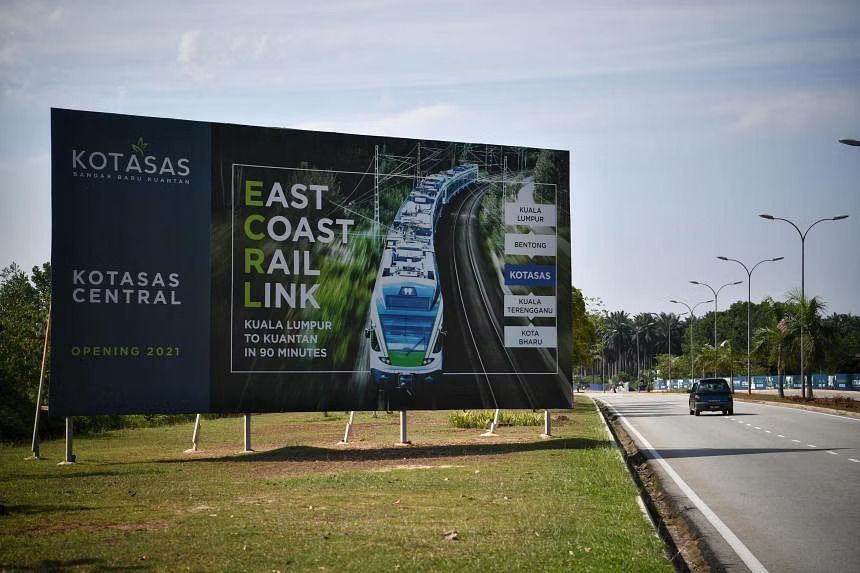KUALA LUMPUR (ANN/THE STRAITS TIMES) – Chinese Premier Li Qiang’s arrival in Kuala Lumpur on Tuesday not only marks the fifty-year anniversary of bilateral relations between China and Malaysia but also places a spotlight on Malaysia’s ambitious infrastructure plans, particularly the East Coast Rail Link (ECRL).
During his two-day visit from June 19 – 20, Premier Li is scheduled to meet with Prime Minister Anwar Ibrahim and Malaysia’s King, Sultan Ibrahim Iskandar, focusing on expected economic collaborations and the signing of memorandums of understanding across various sectors.
Of particular significance is Premier Li’s attendance at the “ground-breaking ceremony” at the Gombak construction site of the ECRL on Wednesday.
This project, financed by a Chinese bank and executed by a Chinese firm, symbolises Malaysia’s commitment to expanding its transportation network.
Transport Minister Anthony Loke recently suggested that the ECRL could become part of a broader pan-Asian rail network, potentially linking Malaysia with Thailand and ultimately connecting to Kunming, China, via Laos.
The ECRL extension beyond its current Kelantan terminus underscores Malaysia’s strategic vision under the Belt and Road Initiative (BRI), aiming to enhance regional connectivity and bolster economic ties with China.
This proposal came after the Thai legislature on Feb 16 voted in favour of a so-called land bridge across the country’s south, a transport route that would bypass the entire Malacca Strait and Singapore.
“Thailand wants China’s help for the land bridge, but we are suggesting to both Beijing and Bangkok that an ECRL extension is more cost-efficient and benefits everyone instead of a zero-sum game,” a Malaysian government official told The Straits Times on condition of anonymity ahead of the Premier’s visit.
The ECRL dates back to when Najib Razak – Tun Abdul Razak’s son – was prime minister from 2009 to 2018, which was a high-water mark for bilateral relations as a slew of BRI projects were announced.

Several of these projects have now fallen by the wayside since Najib’s election defeat and subsequent jailing over the 1MDB scandal.
Chinese President Xi Jinping visited Malaysia in 2013, which led to an elevation of relations to a Comprehensive Strategic Partnership, before then Premier Li Keqiang attended the East Asian leaders’ meeting hosted by Malaysia in 2015.
Hence, Li Qiang will be the highest-ranking Chinese official to visit Malaysia in nearly a decade, and his presence will be symbolic of Beijing’s backing for what remains the most important BRI deal in Malaysia, which was nearly cancelled along with several others after Najib lost power.
Tun Dr Mahathir Mohamad, who returned to the helm from 2018 to 2020, told ST that several of those deals were “detrimental to Malaysia’s economy”, including the ECRL.
“The cost was very high and (it was) not a necessary project. The contract was given to a Chinese company, the workers were from China, the finance was from China. Everything was from China, to the point where the profit was declared in China, so we don’t even collect tax,” he said in an interview with ST in May.
Dr Mahathir’s administration had renegotiated the deal then, bringing down the construction cost by one-third from MYR65.5 billion (SGD18.8 billion) to MYR44 billion, and inserting local subcontractors to work on parts of the project.
Despite that hiccup, the momentum of Malaysia-China economic relations continues to gather pace.
Datuk Seri Anwar, in an interview with Chinese media on June 17, signalled Malaysia’s readiness to join Brics, the economic bloc led by Beijing along with Brazil, Russia, India and South Africa.
According to Malaysia’s Foreign Ministry, Li and Anwar – who visited China twice in 2023 – will witness several memorandums of understanding to foster cooperation in a range of fields, from technology and tourism to housing and higher education.
“The visit itself will be largely symbolic. But even these signals can pave the way for more trade and investment,” Singapore Institute of International Affairs’ senior fellow Oh Ei Sun told ST.
Referencing how Malaysia has mooted a controversial “orang utan diplomacy” akin to how China loans its giant pandas to other nations, he added that “an exchange, orang utans for pandas, without financial consideration, would cement friendship and trust”.
Xing Xing and Liang Liang’s 10-year stay at Malaysia’s national zoo was to have expired in May, with some quarters keen to see the two pandas continue to reside in Malaysia. Three cubs were born during this time, said to be a “world record” rate of reproduction.





